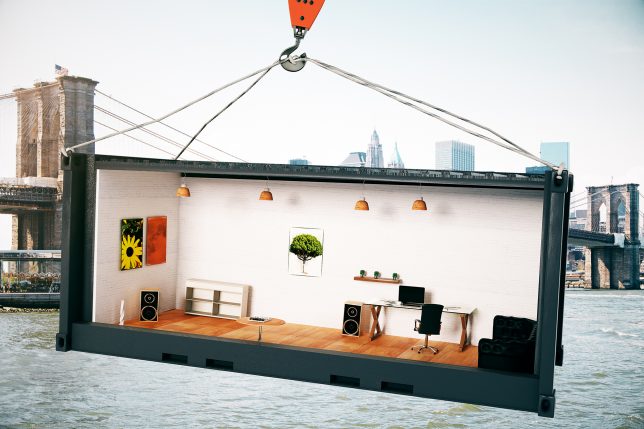
글_곽대원 디자인 길드 소장
“컨테이너로 집을 짓는다는 것은 더 이상 새로운 개념이 아니다. 신기할 것도 없다. 바닥과 벽, 천장이 이미 있으니, 그저 가져다 쌓으면 집이 된다. 가격도 매우 저렴한 것이 당연하다. 컨테이너가 비싸봐야 컨테이너 아닌가?”
이것이 예비 건축주들이 갖고 있는 컨테이너 주택에 관한 보통의 개념이다. 하지만 실제 컨테이너 주택을 지어본 1인으로서 실상은 전혀 그렇지가 않다. 여기저기 컨테이너 집을 짓는다고 공장을 차려놓고 버젓이 영업을 하는 회사, 아니 장사꾼들이 난무하고 있다. 이들을 만나 얘기를 들어보면 건축을 전공한 사람들도 아니다. 컨테이너 주택의 위험성은 그들에게서 비롯된다. 어떻게 하든지 외부 형태는 컨테이너니, 내부만 그럴듯하게 꾸며두면 집인 듯 보일 것이다. 역시 위험하다.
컨테이너는 제대로 된 집이 될 가능성이 매우 크고, 그럴 자격 또한 충분하다. 5층 이상 적층해 흔들리는 배 위에서 수십 시간을 이동하면서도 그들의 배 속에 간직한 이들을 안전하게 지켜준다. 또한 바닷물에도 견디며 빗물이 스며들지도 않는다. 이 얼마나 완벽한 구조물인가? 유목민(Nomad) 같은 현대인의 삶을 반영하고, 쉬운 일은 아니지만 마음만 먹으면 언제든지 이동과 변형이 가능하다. 익숙지 않은 것들에 마음을 빼앗기는 현대인들의 얇디 얇은 감성을 자극하기에도 컨테이너 외관이 주는 장점이 많다.
그렇다면 어떻게 이토록 훌륭한 컨테이너란 녀석에게 제대로 된 주택으로서의 생명을 부여할 수 있을까? 또 건축허가라는 최대의 난제를 어떻게 극복할 수 있을까?

주변을 아무리 돌아봐도 4층 이상 되는 컨테이너 주택은 찾기가 쉽지 않다. 사실 없다. 세계 어디를 봐도 순수하게 컨테이너만 사용해 4층 이상의 주택을 지은 사례는 없다. 전시장이나 상가의 경우는 간혹 보지만, 주택이라는 명칭을 가지려면 훨씬 많은 부분에서 고민스러운 과제를 해결해야 하기 때문에 어렵다.
컨테이너는 일단 주택에 필요한 창문 등의 개구부를 만들면 그 자체로 지니는 완벽한 구조를 상실하게 된다. 이에 따른 구조보강이 필수적이다. 또 건축허가에 맞는 내진 설계의 기준을 충족시키기 위해서는 수직수평으로 별도의 구조보강이 필요하다. 컨테이너의 네 귀퉁이는 겉으로 보이는 것처럼 완벽한 기둥 역할을 할 수가 없기 때문에 기둥의 보강이 필요하다.
컨테이너 하부와 상부를 긴 방향으로 가로지르는 ㄷ자 형태의 부자재 역시 온전한 구조재로서는 부족하니 그 위에 ㄷ자 형태의 캡을 씌워 온전한 보 역할을 하는 부자재로 바꿔줘야 한다. 문짝을 떼어낸 자리는 특히 구조적으로 취약하니 양쪽에 각파이프를 세워 보강해야 한다. 이때 각파이프는 내부에 결로가 생겨 장기적으로 부식의 우려가 있다. 이를 위해 3D 프린터로 만든 플라스틱 소재의 볼트 형태의 벤트(vent)컨테이너 안의 수분을 제거하기 위한 통풍구. 환기가 잘 되지 않으면 컨테이너가 녹슬 수 있기 때문이다. 오렌지큐브는 3D 프린터로 제작한 플라스틱 소재의 육각형 볼트가 그 역할을 하고 있다.를 설치했다.
컨테이너는 단열에 있어서 취약할 것이라는 선입견을 피해갈 수 없다. 뜨거운 햇볕에 철판들이 달궈지면 얼마나 더울까? 이 같은 우려는 컨테이너에 항상 붙어 다니는 의구심이다. 외단열을 하자니 컨테이너로서의 정체성이 흔들린다. 결국 내단열이다. 벽면이 이리저리 꺾여 있으니 일반 단열재를 시공하기도 애매하다. 이를 해결하기 위해 경질 우레탄 폼(form)을 도포했다. 최소 75mm 이상은 도포해야 한다. 컨테이너를 적층하기 전에 이미 컨테이너 바닥면에 50mm를 도포한 상태다. 이어 실내에 벽과 천장에 다시 우레탄 폼을 도포한다. 저렴할 리가 없다.
한쪽 문짝을 떼어내고 나머지 문짝에 지탱해 발코니를 설치했다. 문짝이 모두 사라지는 순간, 왠지 컨테이너의 정체성은 반쪽만 남을 듯하다. 컨테이너를 닮은 구조물들로 적층해 만든 문화공간들처럼 ‘네가 진짜 컨테이너냐’라는 질문도 피해가고 싶다.
‘외부공간은 많을수록 좋다’라는 건축적 고집도 포함된다. 발코니 하부에 사선으로 접은 철판을 달아 물받이 역할을 부여함과 동시에 복잡하기만 한 컨테이너의 외면에 조금은 단순한 오브제를 병치시켜 눈이 쉬어가게 한다.
컨테이너를 다룰 때는 최대한 기존 구조체를 유지하는 게 좋다. 그렇지 않으면 일반 철골 건물과 다를 게 없다. 그러다 보니 주택 내부의 방 구조가 일반적이지는 않다. 오렌지큐브 내부에는 총 5개의 방이 있다. 각 방에는 개별 화장실과 각각 두 개의 방이 더 있다. 하나는 침실, 하나는 드레스룸 또는 공부방이 될 것이다. 모든 방들이 여느 주택의 안방만큼의 퀄리티를 갖는다. 엄마 아빠만 은밀한 사생활이 있는 것은 아니지 않는가.
오렌지큐브는 게스트하우스에 더 적합하다는 건축주의 판단에 의해 현재 그 용도로 운영 중이다. 덕분에 누구나 컨테이너 주택을 경험할 수 있게 됐다. 설계자이자 시공자인 나 또한 이곳에 사무실을 운영하면서 컨테이너 주택이 주는 많은 혜택과 문제점을 직접 경험하고 있다. 그 경험이 다음을 준비하게 한다.
Written by Daewon Kwak | Chief Architect of Design Guild
“It is no longer a new concept. It is nothing interesting. If you already have the floor, the wall, and the ceiling, you have a house. It’s natural that the price is low. After all, a container is a container.”
That’s what potential clients think about shipping container homes. However, to someone who has built one, this perception is far from reality. There are just too many peddlers who say they build houses out of shipping containers. I’ve talked to some of them and found out they never even studied architecture. The risks that come with building a shipping container home start right there. There’s also this idea that the exterior is a shipping container and if you just make the inside nice, now you’ve got a house. That’s a risky idea, too.
A shipping container is filled with the possibility of becoming a proper home, and it deserves to be one. A shipping container protects its cargo, moving dozens of hours inside a wobbling ship, with one box stacked on top of the other. A shipping container can endure seawater and heavy rain. How perfect a structure is that? Such a box contains within it the lives of today’s modern nomads. When a person wants to move on, the shipping container transforms and moves however and to wherever they want it to be. The exterior also works to stimulate the flickering sensibilities of modern people, who are drawn to unfamiliar things.
So now the question is: Can you blow life into this shipping container to make it a proper home? And more importantly, how do you get a construction permit?

It is very rare to find a shipping container home of over four stories. Actually, there aren’t any. There is nowhere in the whole wide world where you’ll see four shipping containers stacked up with no support. Here and there you may see an exhibition space or the odd shop, but it takes so much more for a box to become a house.
A shipping container loses its so-called perfect structure when you make an opening for the windows and doors in order to convert it into a living space. It is essential to bolster the structure. To satisfy earthquake-proof engineering standards for construction permits, you need separate vertical structure supplements. What’s more, you have to add support to the four corners of the container, because they don’t work as columns for a building.
The U-shaped material that horizontally crosses the top and bottom of a shipping container is also insufficient for the structure, so you need another U-shaped cap to convert the girders into a complete beam. The slot for the door is particularly weak in its structure, and has to be reinforced with pipes on each side. The pipes can corrode over time due to condensation. To prevent this from happening to Orange Cube, I installed bolt-shaped vents that I created with my 3D printer.
Shipping containers are also very frail when it comes to insulation. Steel can get burning hot in the blazing sun. If you insulate the box on the outside, the home loses its essential character as a shipping container. If you insulate it on the inside, the crooked walls are not cut out for normal insulation materials. For Orange Cube, we sprayed the shipping containers with a rigid urethane foam at least 75mm thick. Prior to stacking the boxes, a 50mm layer of the foam was added to the floor, walls, and ceiling. The process wasn’t cheap.
We cut one of the doors out on one side of each shipping container and put the balcony on the opposite door. I felt that if all the doors were gone, the shipping containers would lose half their original identity. It was imperative that they maintain their distinctiveness as shipping containers.

I also worked on creating more outdoor space. I attached a diagonally folded steel panel to the bottom of the balcony to serve as waterspout. The result transcends the simple lines of a shipping container by making an objet the focal point.
Working with a shipping container, it’s always best to maintain the basic structure. That’s why the room layout in Orange Cube is unconventional. The building features five units, each with two rooms and a bathroom. In each unit, one room is a bedroom and the other can serve as a dressing room or study. Each room works just as you’d expect from a proper house.
I decided to use Orange Cube as a guesthouse, and it’s good that way. It is open to everyone. As a designer and a builder, I also reside and work in the space and get to experience the benefits and the issues that come with this space. This experience has prepared me for the next opportunity.